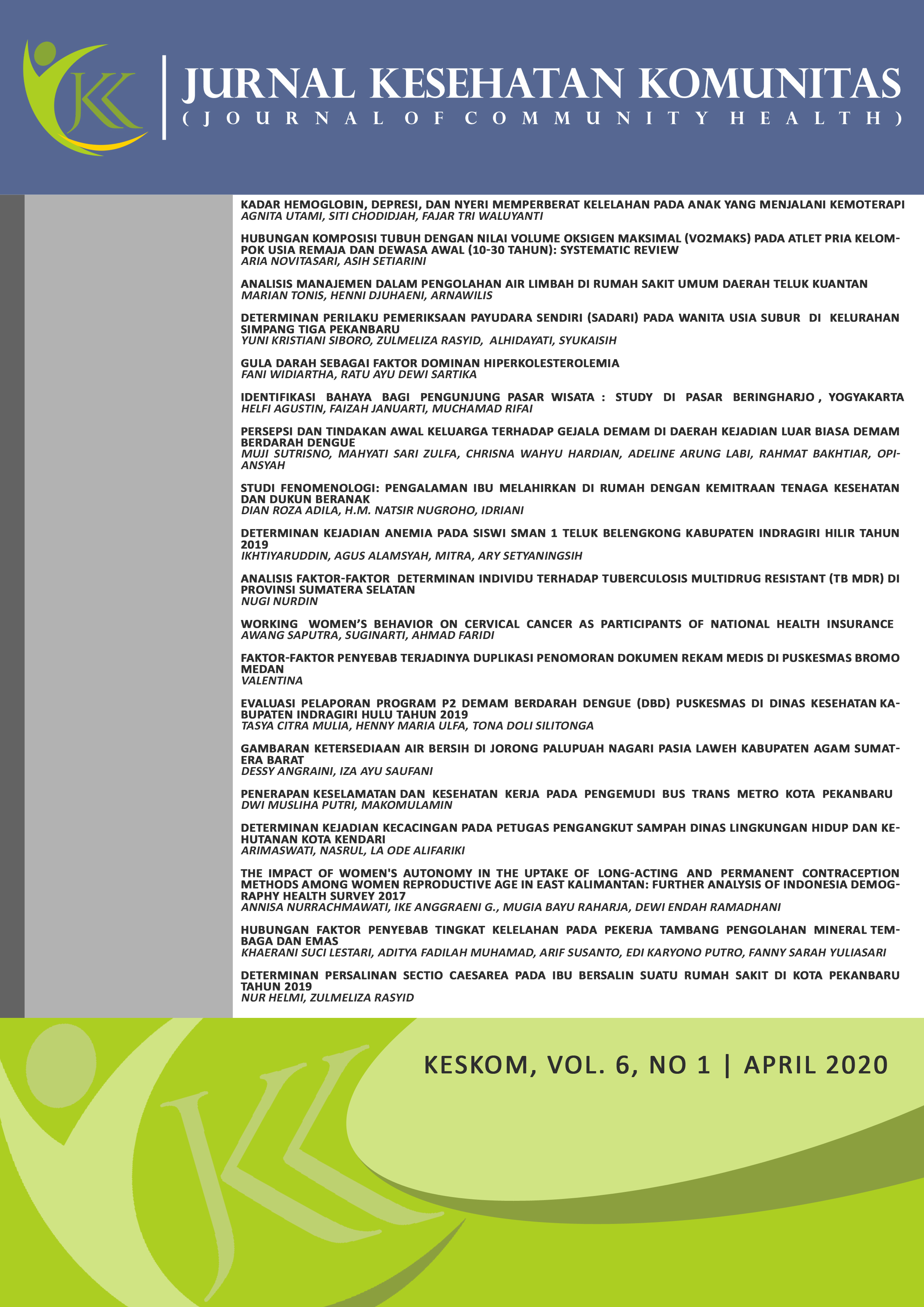The Effect of Women's Autonomy in the Uptake of Long-Acting and Permanent Contraception Methods among Women Reproductive Age in East Kalimantan
DOI:
https://doi.org/10.25311/keskom.Vol6.Iss1.511Keywords:
Keywords: Family planning, women autonomy, long acting contraceptive methodsAbstract
Background: Despite decreased fertility rate, East Kalimantan Province still facing unmet needs. Moreover, almost all contraceptive use in East Kalimantan depends on short-acting contraceptive methods. Only a few studies have ever been conducted on women's autonomy in relation to Long-Acting Permanent Contraception Methods (LAPMs) choices. It is, therefore, essential to find the associated factors affecting LAPMs uptake. This study aimed to analyze the influence of sociodemographic, knowledge, women's autonomy and fertility on LAPMs uptake at the household level.
Methods: The data derived from the Indonesian Demographic and Health Survey (IDHS) 2017 of East Kalimantan Province. As much as 570 women of childbearing age (10–49 years) with marital status who still using contraception in any method was included as samples.
Results: Factors correlate with the uptake of LAPMs in the bivariate analysis were age, insurance ownership, family planning knowledge and women's autonomy (p value<0.05). While in the multivariate analysis only women autonomy and insurance ownership were related to the uptake of LAPMs.
Conclusion: This finding provides evidence for including women empowerment programs in the family planning program.
Keywords: Family planning, women autonomy, long acting contraceptive methods
Downloads
References
Alabi, O., Odimegwu, C. O., De-Wet, N., & Akinyemi, J. O. (2019). Does female autonomy affect contraceptive use among women in northern Nigeria? African Journal of Reproductive Health, 23(2), 92–100. https://doi.org/10.29063/ajrh2019/v23i2.9
ALSumri, H. H. (2015). A national study: The effect of egyptian married women’s decision-making autonomy on the use of modern family planning methods. African Journal of Reproductive Health, 19(4), 68–77.
Bhandari, R., Pokhrel, K., Gabrielle, N., & Amatya, A. (2019). Long acting reversible contraception use and associated factors among married women of reproductive age in Nepal. PLOS ONE, 14, e0214590. https://doi.org/10.1371/journal.pone.0214590
Carlin, C. S., Fertig, A. R., & Dowd, B. E. (2016). Affordable care act’s mandate eliminating contraceptive cost sharing influenced choices of women with employer coverage. Health Affairs, 35(9), 1608–1615. https://doi.org/10.1377/hlthaff.2015.1457
Creanga, A. A., Gillespie, D., Karklins, S., & Tsui, A. O. (2011). Faible recours à la contraception chez les femmes africaines pauvres: Une question d’égalité. Bulletin of the World Health Organization, 89(4), 258–266. https://doi.org/10.2471/BLT.10.083329
Ilmiyah, D., Budihastuti, U., Nurhaeni, I., & Mudigdo, A. (2018). Determinants of Women’s Choice of a Long-Acting Reversible Contraceptive in Boyolali, Central Java. Journal of Maternal and Child Health, 03, 225–232. https://doi.org/10.26911/thejmch.2018.03.03.07
Judge, C. P., Wolgemuth, T. E., Hamm, M. E., & Borrero, S. (2017). “Without bodily autonomy we are not freeâ€: exploring women’s concerns about future access to contraception following the 2016 US presidential election. Contraception, 96(5), 370–377. https://doi.org/10.1016/j.contraception.2017.07.169
Kohan, S., Talebian, F., & Ehsanpour, S. (2014). Association between women’s autonomy and family planning outcome in couples residing in Isfahan. Iranian Journal of Nursing and Midwifery Research, 19, 451–455.
Mutombo, N., & Bakibinga, P. (2014). The effect of joint contraceptive decisions on the use of Injectables, Long-Acting and Permanent Methods (ILAPMs) among married female (15-49) contraceptive users in Zambia: A cross-sectional study. Reproductive Health, 11, 51. https://doi.org/10.1186/1742-4755-11-51
Potts, M. (2014). Getting family planning and population back on track. Global Health Science and Practice, 2(2), 145–151. https://doi.org/10.9745/GHSP-D-14-00012
Tibaijuka, L., Odongo, R., Welikhe, E., Mukisa, W., Kugonza, L., Busingye, I., … Bajunirwe, F. (2017). Factors influencing use of long-acting versus short-acting contraceptive methods among reproductive-age women in a resource-limited setting. BMC Women’s Health, 17. https://doi.org/10.1186/s12905-017-0382-2
Vouking, M. Z., Evina, C. D., & Tadenfok, C. N. (2014). Male involvement in family planning decision making in sub-Saharan Africa- what the evidence suggests. Pan African Medical Journal, 19, 1–5. https://doi.org/10.11604/pamj.2014.19.349.5090
Wado, Y. D., Afework, M., & Hindin, M. (2013). Unintended pregnancies and the use of maternal health services in Southwestern Ethiopia. BMC International Health and Human Rights, 13, 36. https://doi.org/10.1186/1472-698X-13-36
Zerden, M. L., Tang, J. H., Stuart, G. S., Norton, D. R., Verbiest, S. B., & Brody, S. (2015). Barriers to Receiving Long-acting Reversible Contraception in the Postpartum Period. Women’s Health Issues, 25(6), 616–621. https://doi.org/10.1016/j.whi.2015.06.004

Downloads
Submitted
Accepted
Published
How to Cite
Issue
Section
License
Copyright (c) 2020 Jurnal Kesehatan Komunitas

This work is licensed under a Creative Commons Attribution-NonCommercial-ShareAlike 4.0 International License.




























